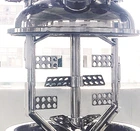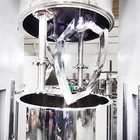Mastering Emulsions: How Vacuum Emulsifying Mixers Improve Creams & Sauces
Emulsions play a crucial role in both the food and cosmetic industries. Whether it’s a rich béarnaise sauce, a dairy-based cream, a luxurious moisturizer, or a pharmaceutical ointment, the quality of an emulsion affects how a product looks, feels, tastes, and performs over time.
An emulsion is a stable mixture of two immiscible liquids—usually oil and water. Achieving a consistent, appealing, and durable emulsion is a technical challenge that standard mixers often struggle to meet.
Common Industry Challenges
Without precise control during production, manufacturers may encounter:
- Inconsistent droplet sizes, leading to separation.
- Trapped air and foam, which can reduce shelf life and cause oxidation.
- Unstable texture, resulting in grainy or greasy products.
- Heat-sensitive ingredient degradation, affecting flavor, color, or bioactivity.
- Scaling issues, where lab-proven methods fail in larger production environments.
These challenges highlight the need for more advanced processing solutions—this is where Vacuum Emulsifying Mixers (VEMs) come into play.
What Is a Vacuum Emulsifying Mixer?
This mixer is a high-performance processing system designed to create stable, finely dispersed, air-free emulsions under vacuum conditions. Unlike conventional mixers, VEMs integrate multiple functions—mixing, homogenizing, heating/cooling, and deaeration—into one automated unit.
Key Technical Components:
- Vacuum System: Removes oxygen and air during processing.
- High-Shear Rotor-Stator Mixer: Reduces droplet sizes to as small as 1–2 microns.
- Inline or Bottom homogenizer: Ensures uniform particle distribution.
- Jacketed Mixing Vessel: Allows precise thermal control.
- PLC/HMI Control Panel: Enables automation, repeatability, and batch tracking.
Advanced systems may also include:
- CIP/SIP (Clean/Steam-In-Place) functionality.
- Scraper blades for high-viscosity products.
- Gravimetric dosing systems for accurate ingredient delivery.
How VEMs Enhance Product Quality
Let’s look at how VEMs solve specific formulation challenges:
1. Air Removal = Longer Shelf Life
Operating under vacuum eliminates air bubbles that:
- Accelerate oxidation in oils and fats.
- Promote microbial growth in food products.
- Create foam or visible textural flaws.
2. Smaller Droplets = Smoother Texture
High shear mixing and homogenization break emulsions into ultra-fine particles:
- Enhances mouthfeel in sauces and dressings.
- Produces a rich, silky texture in creams and lotions.
- Prevents phase separation during storage.
3. Thermal Control = Ingredient Protection
Precise temperature regulation helps:
- Protect heat-sensitive ingredients (e.g., proteins, essential oils, actives).
- Prevent burning, discoloration, or denaturation.
- Support emulsions requiring temperature cycles.
4. Scalability = Consistent Batches
VEMs are available in a wide range of sizes:
- From lab-scale (10L) to industrial-scale (10,000L).
- Recipe memory and automation ensure reproducibility.
- Ideal for scaling R&D formulations to full production.
Real-World Applications
|
Industry |
Typical Products |
Why VEM Is Beneficial |
|
Food |
Mayonnaise, sauces, salad dressings |
Improved texture, air-free finish, extended shelf life |
|
Cosmetics |
Face creams, sunscreens, lotions |
Smooth texture, stable emulsions, glossy appearance |
|
Pharmaceuticals |
Topical creams, gels, ointments |
Uniform API distribution, sterile process compliance |
|
Nutraceuticals |
Omega-3 blends, protein emulsions |
Flavor masking, protection of active compounds |
Important Considerations Before Investing
While VEMs offer significant benefits, here are some practical considerations:
1. High Initial Cost
- VEMs are more expensive than standard mixers.
- Costs depend on capacity, automation level, and customization.
- May require upgrades to facility space or utilities.
Tip: Consider the unique properties of your product and customize the VEM accordingly. (See our article “Best Mixing Equipment for High-Viscosity Products” for more details.)
2. Learning Curve
- Operators need training in vacuum processing and recipe management.
- Incorrect settings can lead to poor results or wear on parts.
Tip: Allocate time for proper onboarding—cutting corners here can lead to costly downtime.
3. Maintenance & Cleaning
- While CIP systems help, manual inspection may still be needed.
- Mechanical components like seals and homogenizers require regular upkeep.
Tip: Ensure your supplier provides easy access to spare parts and responsive support. (See our article “Top 5 Mistakes to Avoid When Buying a Filling Machine: Vendor & Support-Related” to choose the best supplier.).
4. Overprocessing Risks
- Too much shear can break down fragile emulsions.
- Some ingredients (e.g., starches, gums) may react unpredictably.
Tip: Consider starting with a laboratory-scale VEM to dial in optimal parameters before scaling up. (Read the article “Introduction of Laboratory Vacuum Emulsification Mixer Machine” for more information.)
Is a VEM Right for You?
A Vacuum Emulsifying Mixer is a smart investment if your production goals include:
- Delivering premium product quality (smoothness, stability, clean label).
- Scaling to high-volume production with batch consistency.
- Reducing reliance on stabilizers and additives.
- Improving efficiency in labor and processing time.
For companies in food, cosmetics, pharmaceuticals, or nutraceuticals, the long-term ROI can be substantial:
- Lower production costs through reduced waste and rework.
- Faster batch cycles.
- Improved product reliability and shelf presence.
- Stronger brand trust through consistent quality.
Conclusion: A Precision Tool for Serious Emulsions
Vacuum Emulsifying Mixers are not just upgraded blenders—they’re precision processing systems designed to deliver reliable, high-quality emulsions at scale. In industries where appearance, texture, and shelf life are critical, VEMs offer a measurable edge.
Although the initial investment and training requirements may seem steep, the payoff in operational efficiency, product consistency, and brand reputation often makes them well worth it.
Bottom line: If your product depends on mastering emulsions, a VEM helps you master the entire process.














































































































